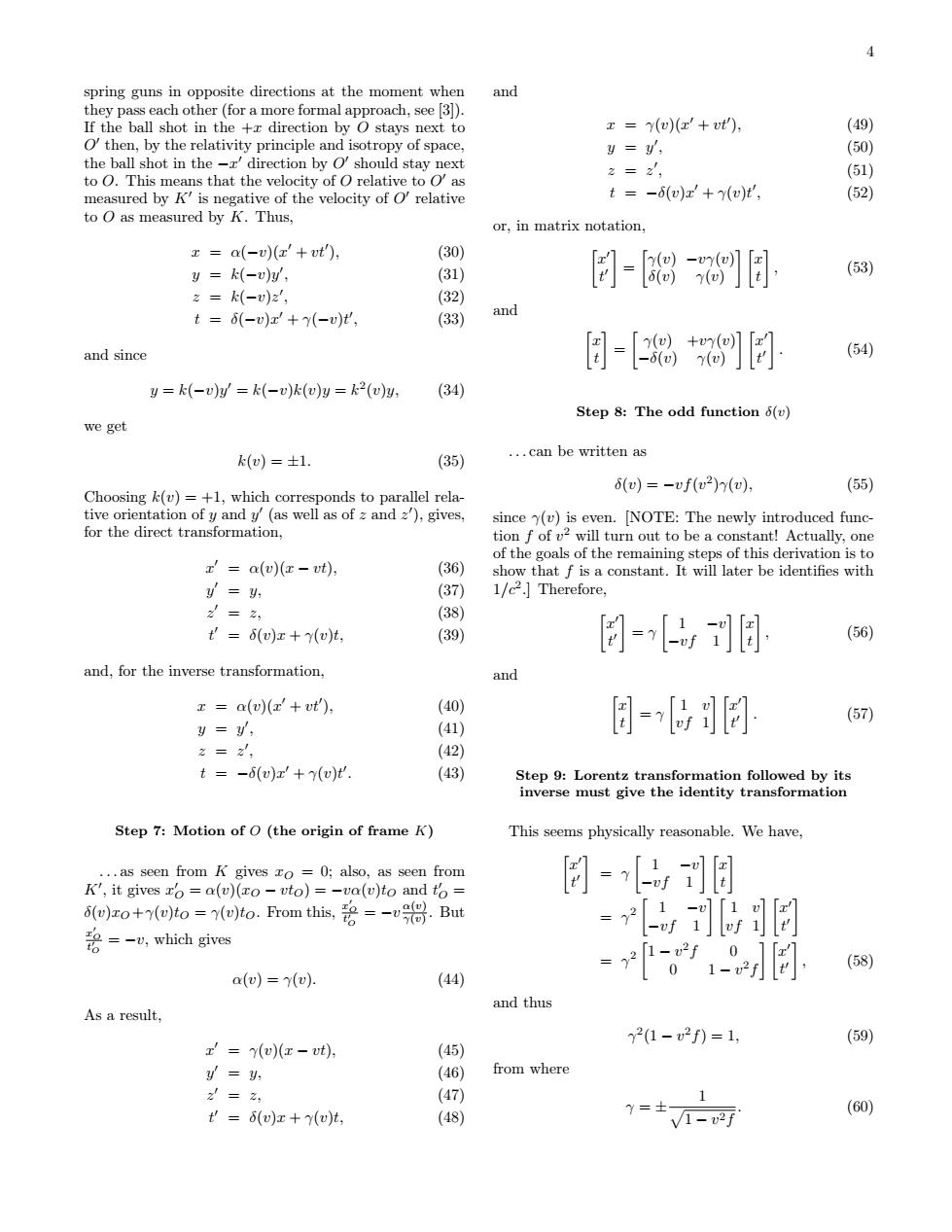正在加载图片...

4 spring guns in opposite directions at the moment when and they pass each other(for a more formal approach,see [3]). If the ball shot in the +x direction by O stays next to z Y(v)(x'+vt'), (49) O'then,by the relativity principle and isotropy of space, y-y, (50) the ball shot in the-z'direction by O'should stay next z=2, to O.This means that the velocity of O relative to O'as (51) measured by K'is negative of the velocity of O'relative t=-6(v)x+y()t', (52) to O as measured by K.Thus, or,in matrix notation, x=a(-v)(x'+vt), (30) y=k(-v), (31) (53) z=k(-U)z', (32) t=6(-v)x+y(-v)t, (33) and and since -[品+目 (54) y=k(-v)y=k(-v)k(v)y=k2(v)y, (34) Step 8:The odd function 6(v) we get k()=士1. ..can be written as (35 6v)=-vf(u2)(w), (55) Choosing k(v)=+1,which corresponds to parallel rela- tive orientation of y and y'(as well as of z and 2),gives, since y(v)is even.[NOTE:The newly introduced func- for the direct transformation, tion f of v2 will turn out to be a constant!Actually,one of the goals of the remaining steps of this derivation is to I'=a(v)(z-vt); (36) show that f is a constant.It will later be identifies with y=y, (37) 1/c2.]Therefore, d=2, (38) t'=6(v)x+y(v)t, (39) 同=到同 (56) and,for the inverse transformation, and x=a()(x'+vt), (40) 同-同 (57) y=, (41) z=, (42) t=-6(v)x'+y(u)t. (43) Step 9:Lorentz transformation followed by its inverse must give the identity transformation Step 7:Motion of O(the origin of frame K) This seems physically reasonable.We have, ..as seen from K gives o 0;also,as seen from K';it gives o =a(v)(zo-uto)=-va(v)to and to 周=到目 6()o+)to=7(u)to.From this,But =y2 号=-u,which gives (58) a(v)=7(v). (44) and thus As a result, 2(1-w2f)=1, (59) I'=7(v)(I-vt), (45) =, (46) from where 2=2, (47) 1 t'=8(v)I+7(v)t, (48) Y=士 V1-v2f (60)4 spring guns in opposite directions at the moment when they pass each other (for a more formal approach, see [3]). If the ball shot in the +x direction by O stays next to O0 then, by the relativity principle and isotropy of space, the ball shot in the −x 0 direction by O0 should stay next to O. This means that the velocity of O relative to O0 as measured by K0 is negative of the velocity of O0 relative to O as measured by K. Thus, x = α(−v)(x 0 + vt0 ), (30) y = k(−v)y 0 , (31) z = k(−v)z 0 , (32) t = δ(−v)x 0 + γ(−v)t 0 , (33) and since y = k(−v)y 0 = k(−v)k(v)y = k 2 (v)y, (34) we get k(v) = ±1. (35) Choosing k(v) = +1, which corresponds to parallel relative orientation of y and y 0 (as well as of z and z 0 ), gives, for the direct transformation, x 0 = α(v)(x − vt), (36) y 0 = y, (37) z 0 = z, (38) t 0 = δ(v)x + γ(v)t, (39) and, for the inverse transformation, x = α(v)(x 0 + vt0 ), (40) y = y 0 , (41) z = z 0 , (42) t = −δ(v)x 0 + γ(v)t 0 . (43) Step 7: Motion of O (the origin of frame K) . . . as seen from K gives xO = 0; also, as seen from K0 , it gives x 0 O = α(v)(xO − vtO) = −vα(v)tO and t 0 O = δ(v)xO +γ(v)tO = γ(v)tO. From this, x 0 O t 0 O = −v α(v) γ(v) . But x 0 O t 0 O = −v, which gives α(v) = γ(v). (44) As a result, x 0 = γ(v)(x − vt), (45) y 0 = y, (46) z 0 = z, (47) t 0 = δ(v)x + γ(v)t, (48) and x = γ(v)(x 0 + vt0 ), (49) y = y 0 , (50) z = z 0 , (51) t = −δ(v)x 0 + γ(v)t 0 , (52) or, in matrix notation, x 0 t 0 = γ(v) −vγ(v) δ(v) γ(v) x t , (53) and x t = γ(v) +vγ(v) −δ(v) γ(v) x 0 t 0 . (54) Step 8: The odd function δ(v) . . . can be written as δ(v) = −vf(v 2 )γ(v), (55) since γ(v) is even. [NOTE: The newly introduced function f of v 2 will turn out to be a constant! Actually, one of the goals of the remaining steps of this derivation is to show that f is a constant. It will later be identifies with 1/c2 .] Therefore, x 0 t 0 = γ 1 −v −vf 1 x t , (56) and x t = γ 1 v vf 1 x 0 t 0 . (57) Step 9: Lorentz transformation followed by its inverse must give the identity transformation This seems physically reasonable. We have, x 0 t 0 = γ 1 −v −vf 1 x t = γ 2 1 −v −vf 1 1 v vf 1 x 0 t 0 = γ 2 1 − v 2f 0 0 1 − v 2f x 0 t 0 , (58) and thus γ 2 (1 − v 2 f) = 1, (59) from where γ = ± 1 p 1 − v 2f . (60)